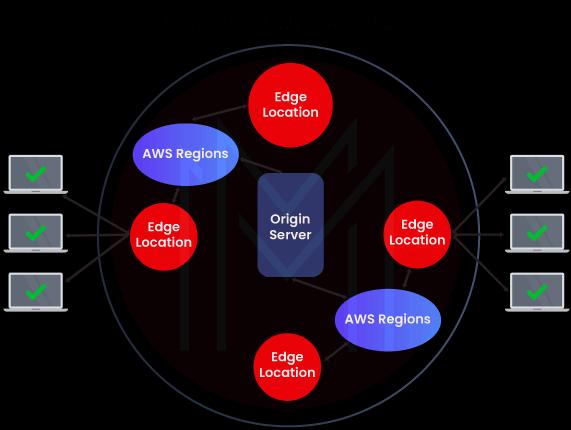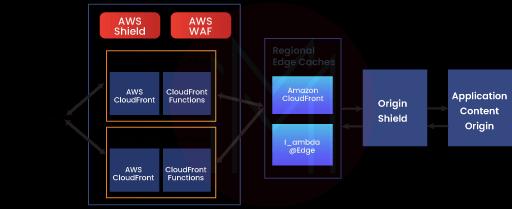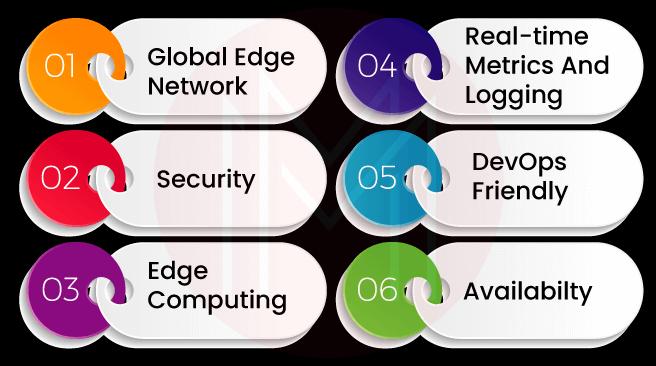- Introduction to Amazon Elastic File System
- Amazon On-Demand Instance Pricing
- AWS Kinesis
- Amazon Redshift Tutorial
- Amazon SageMaker - AIs Next Game Changer
- AWS Console - Amazon Web Services
- AWS Architect Interview Questions
- AWS Architecture
- Amazon Athena
- Top 11 AWS Certifications List and Exam Learning Path
- How to Create Alarms in Amazon CloudWatch
- AWS CloudWatch Tutorial
- Introduction To AWS CLI
- AWS Configuration
- AWS Data Pipeline Documentation
- AWS EC2 Instance Types
- AWS Elastic Beanstalk
- AWS Elastic Beanstalk Available in AWS GovCloud (US)
- AWS Free Tier Limits and Faq
- AWS EC2 Instance Pricing
- Choosing The Right EC2 Instance Type For Your Application
- AWS Interview Questions And Answers
- AWS Key Management Service
- AWS Lambda Interview Questions
- AWS Lambda Tutorial
- What Is AWS Management Console?
- Complete AWS Marketplace User Guide
- AWS Outage
- AWS Reserved Instances
- AWS SDK
- What is AWS SNS?
- AWS Simple Queue Service
- AWS SysOps Interview Questions
- AWS vs Azure
- AWS Vs Azure Vs Google Cloud Free Tier
- Introduction to AWS Pricing
- Brief Introduction to Amazon Web Services (AWS)
- Clean Up Process in AWS
- Creating a Custom AMI in AWS
- Creating an Elastic Load Balancer in AWS
- How to Deploy Your Web Application into AWS
- How to Launch Amazon EC2 Instance Using AMI?
- How to Launch Amazon EC2 Instances Using Auto Scaling
- How to Sign Up for the AWS Service?
- How to Update Your Amazon EC2 Security Group
- Process of Installing the Command Line Tools in AWS
- Big Data in AWS
- Earning Big Money With AWS Certification
- AWS Certification Without IT Experience. Is It Possible?
- How to deploy a Java enterprise application to AWS cloud
- What is AWS Lambda?
- Top 10 Reasons To Learn AWS
- Run a Controlled Deploy With AWS Elastic Beanstalk
- Apache Spark Clusters on Amazon EC2
- Top 30 AWS Services List in 2024
- What is Amazon S3? A Complete AWS S3 Tutorial
- What is AMI in AWS
- What is AWS? Amazon Web Services Introduction
- What is AWS Elasticsearch?
- What is AWS ELB? – A Complete AWS Load Balancer Tutorial
- What is AWS Glue?
- AWS IAM (Identity and Access Management)
- AWS IoT Core Tutorial - What is AWS IoT?
- What is Cloud Computing - Introduction to Cloud Computing
- Why AWS Has Gained Popularity?
- Top 10 Cloud Computing Tools
- AWS Glue Tutorial
- AWS Glue Interview Questions
- AWS S3 Interview Questions
- AWS Projects and Use Cases
- AWS VPC Interview Questions and Answers
- AWS EC2 Tutorial
- AWS VPC Tutorial
- AWS EC2 Interview Questions
- AWS DynamoDB Interview Questions
- AWS API Gateway Interview Questions
- How to Become a Big Data Engineer
- What is AWS Fargate?
- AWS CloudWatch Interview Questions
- What is AWS CloudFormation?
- What is AWS Cloudformation
- Cloud Computing Interview Questions
- What is AWS Batch
- What is AWS Amplify? - AWS Amplify Alternatives
- Types of Cloud Computing - Cloud Services
- AWS DevOps Tutorial - A Complete Guide
- What is AWS SageMaker - AWS SageMaker Tutorial
- Amazon Interview Questions
- AWS DevOps Interview Questions
- Cognizant Interview Questions
- Cognizant Genc Interview Questions
- Nutanix Interview Questions
- Cloud Computing Projects and Use Cases
- test info
In today’s fast-moving world, be it a product or a service – everything needs to be planned and delivered as fast as possible to end-users. No doubt any delay in the delivery would push you back out of your competitors. This way, content delivery service is no less than any other service or product. It needs to be delivered to users quickly and at the same time securely.
For example, Spotify, Netflix, etc., provides its customers with quick and secure content delivery, such as Video on Demand (VOD) and live video streaming. So, the right technology that provides fast and secure content to end-users is highly-sought by companies. This way, AWS CloudFront is one of the most-sought content delivery services by companies across the globe for effective content delivery.
This blog sheds light on the basics of AWS CloudFront, its working principle, key features, use cases, and benefits in greater detail.
AWS CloudFront: Table Of Contents
- What is AWS CloudFront?
- Why AWS CloudFront?
- How does AWS CloudFront work?
- What are the Features of AWS CloudFront?
- What are the Use-cases of AWS CloudFront?
- What are the Pricing details of AWS CloudFront services?
- What are the Benefits of AWS CloudFront?
What is AWS CloudFront?
AWS CloudFront is one of the global content delivery services that provide high-performance content delivery. In other words, it is a web service that delivers quick content to end-users with low latency. The content can be static or dynamic such as websites, apps, videos, APIs, images, etc. Moreover, AWS CloudFront allows you to customise content delivery. As a result, you can effectively balance content delivery's speed, cost, and security.
Know that AWS CloudFront delivers content to its users with the help of a global Content Delivery Network (CDN) or edge network made up of Points of Presence (PoP). PoPs are nothing but edge locations as well as AWS region centers or caches. Here, edge locations are vital in delivering content with low latency.

This is because they act as data centers in the global edge network and quickly pass contents to end-users. The essential thing about AWS CloudFront is that it performs highly-efficient content delivery with high data transfer rates. As a whole, it ensures availability, reliability, and security in content delivery.
| If you would like to become an AWS Certified professional, then visit Mindmajix - A Global online training platform: "Online AWS Training ".This course will help you to achieve excellence in this domain. |
Why AWS CloudFront?
As you know, AWS CloudFront simplifies content delivery with low latency and high security. Are you like to know the reasons behind this? Here are they:
- It optimises content delivery with an AWS global delivery network. It means that it ensures seamless content delivery using PoPs distributed across the world
- It executes automated network mapping and intelligent routing for making effective content delivery
- It enhances the security of contents by implementing encryption and access control methods
- It comes with inbuilt data compression and edge-computing facilities
- It uses the AWS shield standard to protect content from DDoS attacks
How does AWS CloudFront work?
Let’s see how AWS CloudFront delivers content to users – step by step – from the request for content to delivering it.
- At first, you need to configure AWS CloudFront based on your content type and applications used.
- Suppose a user accesses your application and raises a request to access an object. Then, the request is routed to the nearest edge location with the help of DNS. Here, the requested object can be an HTML file, an image file, and so on.
- Now, the AWS CloudFront verifies the availability of the requested object in the edge location. CloudFront returns the object to the user with low latency if it is available in the edge location.
- If the requested object is unavailable in the nearest edge location, you can forward the request to the origin servers to fetch the object from there.
- Origin servers will return the object to the nearest edge location of the user.
- Once the edge location receives the object's first byte, it returns the object to the user in no time.
- Mainly, the object is stored in the edge location after that. So, if any user requests the object in the future, it can be immediately delivered to the user with low latency.
In short, when the requested content is available in edge locations, it will be delivered to users immediately. Otherwise, CloudFront fetches the content from the origin servers and delivers it to users. The origin servers can be HTTPS servers, AWS S3 buckets, etc.

What are the Features of AWS CloudFront?
AWS CloudFront has powerful features such as a global edge network, edge computing, enhanced security, DevOps friendliness, real-time metrics, and increased availability.
Let’s discuss them in detail below one by one:
Global Delivery Network: AWS CloudFront uses a global-based content delivery network or edge network of over 410+ PoPs worldwide. In other words, this network has 400+ edge locations and 13 AWS regions. Here, AWS regions are also known as regional mid-tier caches. AWS network backbone is the lifeline of AWS CloudFront that connects all the edge locations and AWS regions. This global edge network ensures reliable, low-latency, secure, and high-throughput network connectivity.
Enhanced Security: AWS CloudFront can integrate and work with various AWS services such as AWS Shield, AWS Route S3, and AWS web application firewall. As a result, it supports increasing the security of delivering content to end-users. This integration can establish a strong security layer that is highly scalable and reliable. It helps prevent DDoS attacks or any other attacks that can be made against the global edge network altogether. Additionally, AWS CloudFront offers customers an advanced transport security layer with which they can securely deliver content, applications, and APIs. Also, it is possible to encrypt and secure communication using this protocol.

Edge Computing: CloudFront offers its users excellent edge computing features that are programmable as well as secure. In this regard, CloudFront functions and AWS lambda@edge are critical drivers in edge computing. First, consider CloudFront functions; they simplify high-scale and latency-sensitive content delivery processes. No surprise cloud functions are good at scaling too. It means that they can quickly process millions of requests per second simultaneously with low latency. Next, consider AWS lambda; essentially, it is a general-purpose serverless computing method. It allows customisation in the content delivery process and simplifies computationally-intensive processes.
Real-time Metrics and Logging: Know that AWS CloudFront generates six operational metrics for a single instance. And it is made with the help of AWS CloudWatch. AWS CloudFront comes with two types of logs: standard and real-time. Standard logs are delivered to the AWS S3 bucket, whereas real-time logs are delivered to the data streams you have chosen from the AWS Kinesis data streams. Not just that, you can decide the sampling rate of real-time logs while working with AWS CloudFront.
DevOps-friendliness: No wonder AWS CloudFront provides DevOps capabilities such as fast propagation as well as invalidations. With the support of a full-fledged API, you can quickly create, maintain, and configure AWS CloudFront instances. CloudFront allows seamless access tools such as AWS Cloudformation, Code commit, Codedeploy, and AWS SDKs for developers. By using AWS CloudFront, you can customise the instance behaviors such as choosing compression modes, caching and forwarding data, and many more. Besides, CloudFront allows you to find the location of the users.
Increased Availability: As you know, Edge locations and AWS regional regions cache contents. So, when a user requests content, the content can be fetched from the edge locations and region caches and delivered to the user. If the requested content is unavailable in the mentioned locations, then the content is fetched from the origin servers. So, the number of origin requests is minimised. Because of this, the availability of applications in origin servers can be increased significantly.
| Also, Checkout "AWS Interview Questions" |
What are the Use-cases of AWS CloudFront?
As AWS CloudFront has many noteworthy features and capabilities, you can undeniably use this tool in many efficient ways. Let’s have a look at them as follows:
High-velocity Static Content Delivery:
No wonder AWS CloudFront executes fast delivery of static objects across the world. The static objects can be style sheets, images, JavaScript, etc. Mainly, the AWS edge network, as well as edge locations, play an essential role in delivering fast, secure, and reliable content delivery to its users. AWS CloudFront works with the AWS S3 bucket in delivering static content simply because the AWS S3 bucket is good in access control.
Delivering dynamic live-streaming Video content and VOD:
If you raise a request to access a Video on Demand (VOD), AWS CloudFront uses the tools such as MPEG DASH, Microsoft smooth streaming, Apple HLS, and CMAF for quick content delivery. Similarly, if you raise a request to access a live stream, AWS CloudFront caches the associated media fragments in edge locations. When there are multiple requests for live streams, AWS CloudFront performs everything in the correct order.
Encrypting Specific Fields for Secure Delivery:
Know that you can implement encryption at the field level with which you can protect specific data throughout its journey in content delivery. In this regard, you can use the public key for encrypting fields. Moreover, configuring HTTPS with CloudFront ensures the security of the origin servers. It allows only specific applications to access objects in origin servers.
Customizing at edge locations:
AWS CloudFront allows customising contents at edge locations by running serverless code, providing low latency. For example, AWS CloudFront returns a custom error message when the origin server you try to access is down due to maintenance. Otherwise, it will enable an HTTPS error message.
Also, AWS CloudFront allows you to use a function to authorise users before forwarding their content requests directly to the origin servers. Moreover, you can use lambda edge with AWS CloudFront to customise content in multiple ways.
What are the Pricing details of AWS CloudFront services?
AWS CloudFront offers customers many pricing schemes considering their various needs and demands. Want to know them in detail? Let’s have a look at below:
Free Tier: Every customer can make data transfer up to 1 TB based on this scheme. They are allowed 10,000,000 HTTP and HTTPS requests. Also, they are allowed for 2,000,000 function invocations. The free-tier scheme is calculated for every month for every customer. Note that the unused data won’t roll over for the next month.
On-demand Pricing: AWS CloudFront charges for all HTTP and HTTPS requests in this pricing method. It is important to note that customers who spend up to 10 TB/month or more will be eligible for discounted pricing. Also, pricing depends on the geographic locations involved in the content delivery process.
CloudFront Saving Bundle: In this pricing type, customers can save up to 30 percent if they make a complete one-year commitment. Also, this bundle comes with free AWS Web Application Firewall (WAF) usage. Importantly, you can use WAF for up to 10% of the committed data usage.
Custom Pricing: According to this pricing, customers must commit data transfer to a minimum of 10 TB every month, which should continue for 12 months. AWS would offer discounts based on how much data transfer a customer commit.
Cloudfront Functions Pricing: In this pricing type, Cloudfront charges customers based on the total number of invocations made in all functions. Cloudfront functions usually make an invocation whenever it responds to a CloudFront event. Cloudfront charges $0.10 per 1 million invocations.
Real-time log requests pricing: The pricing of real-time log requests is based on the number of log lines generated by CloudFront. Cloudfront charges $0.01 for every 1,000,000 loglines generated by its customers.
Pricing for Custom SSL Certificate: Cloudfront charges $ 600 monthly for every custom SSL certificate associated with the CloudFront instances.
| Visit here to Konw mare about "AWS Pricing" |
What are the Benefits of AWS CloudFront?
Of course! There are a lot of merits for customers if they adopt AWS CloudFront. Let’s list them in the following:
- You can transfer contents across global in milliseconds
- You can play high-quality live streams and VOD on any device with absolute consistency
- AWS CloudFront easily scales with high transfer rates
- It automatically distributes patches and updates to its instances.
- On top of all, it is simple to use and boosts productivity significantly.
Conclusion:
In a nutshell, AWS CloudFront is the tool you can use to deliver high-speed and secure content to end-users. It doesn't matter whether it is dynamic or static content, simple or intensive content, AWS CloudFront performs content delivery accurately. Also, this cloud-based service offers many wonderful features, such as edge computing, real-time metrics and logging, scaling, availability, and many more. That’s all! If we are on the same page, this blog might have helped you uncover many insights about AWS CloudFront.
 On-Job Support Service
On-Job Support Service
Online Work Support for your on-job roles.

Our work-support plans provide precise options as per your project tasks. Whether you are a newbie or an experienced professional seeking assistance in completing project tasks, we are here with the following plans to meet your custom needs:
- Pay Per Hour
- Pay Per Week
- Monthly
| Name | Dates | |
|---|---|---|
| AWS Training | Jan 06 to Jan 21 | View Details |
| AWS Training | Jan 10 to Jan 25 | View Details |
| AWS Training | Jan 13 to Jan 28 | View Details |
| AWS Training | Jan 17 to Feb 01 | View Details |

Keerthi Sai is a Senior Writer at Mindmajix with tons of content creation experience in the areas of cloud computing, BI, Perl Scripting. She also creates content on Salesforce, Microstrategy, and Cobit.
















